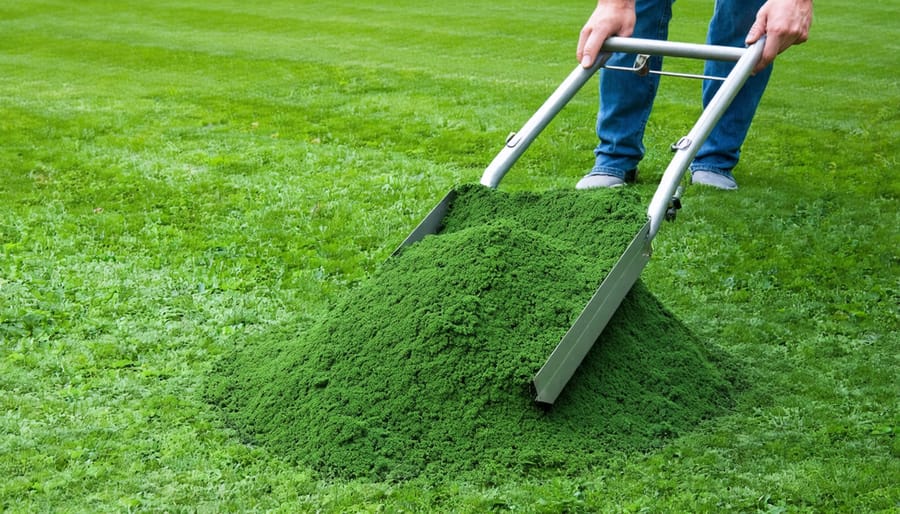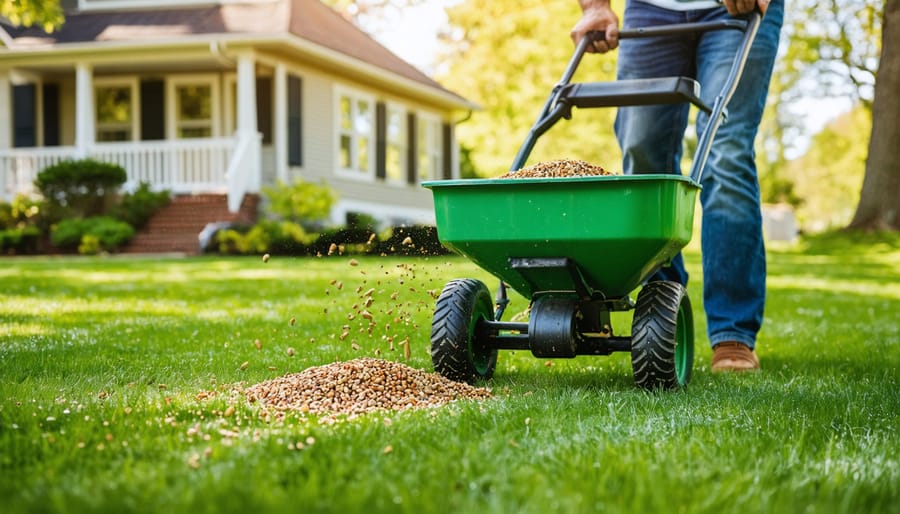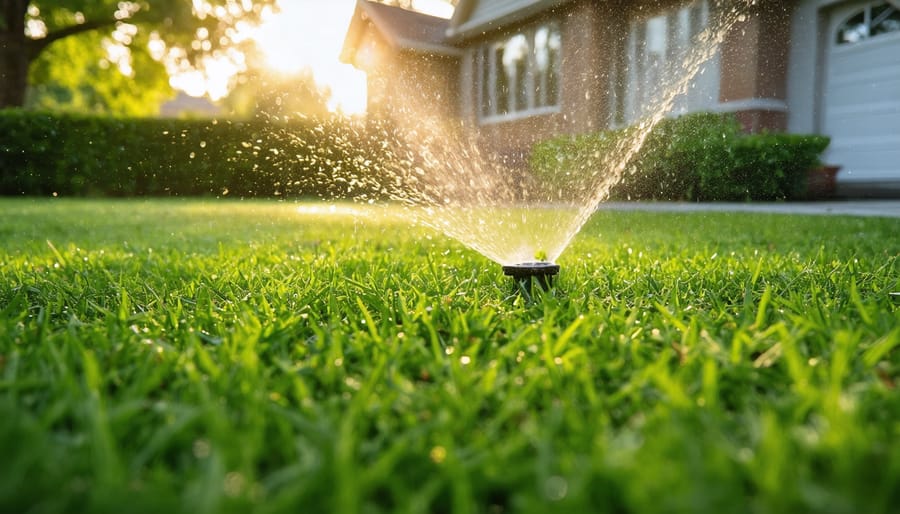Spread organic spring fertilizer when soil temperatures reach 55°F and grass shows active green growth, typically mid-March through May depending on your region. Apply a slow-release formula with a 3-1-2 or 4-1-2 NPK ratio at 20 pounds per 1,000 square feet to fuel robust root development without the chemical burn that synthetic options cause. Water thoroughly within 24 hours of application to activate the microbial activity that makes nutrients available to grass roots.
Spring marks your lawn’s most critical feeding window, and choosing organic over synthetic fertilizers protects beneficial soil organisms while delivering sustained nutrition throughout the growing season. Unlike chemical alternatives that flood grass with quick nitrogen hits followed by rapid depletion, organic options release nutrients gradually as soil microbes break down natural ingredients like feather meal, bone meal, and composted poultry litter. This biological process builds soil health season after season rather than depleting it.
Your spring fertilization success depends on timing, product selection, and preparing your lawn properly before application. Many homeowners make the mistake of fertilizing too early when grass remains dormant, wasting product and risking runoff into watersheds. Others choose formulations better suited for summer maintenance rather than spring growth, missing the opportunity to establish deep root systems that withstand heat and drought later in the year.
The right organic spring fertilizer transforms thin, pale turf into dense, vibrant green coverage while supporting earthworm populations, beneficial bacteria, and mycorrhizal fungi networks that synthetic products destroy. Whether you manage a small suburban yard or expansive property, understanding which organic formulations work best for spring conditions and how to apply them effectively ensures you invest wisely in both your lawn’s appearance and its long-term ecological health.
Understanding Spring Lawn Revival: What Your Grass Really Needs

The Winter Toll on Your Lawn
Winter can be surprisingly harsh on your lawn, even if you don’t live in an area with extreme cold. Those freeze-thaw cycles that characterize late winter and early spring are particularly tough on grass plants and soil structure. As temperatures fluctuate, ice crystals form in the soil, expanding and contracting in a way that can literally heave grass roots right out of the ground. This leaves them exposed and vulnerable to desiccation and damage.
During dormancy, your grass isn’t actively growing, but it’s still alive and slowly depleting the nutrient reserves it stored during fall. By the time spring arrives, those reserves are running on empty. Meanwhile, the soil itself has taken a beating. Compaction from snow, ice, and foot traffic has squeezed out vital air pockets that roots need to breathe and absorb nutrients. Beneficial soil microorganisms that help break down organic matter and make nutrients available to your grass have been largely inactive, creating a backlog of work once temperatures warm up.
The result of all this winter lawn damage is a lawn that emerges from dormancy stressed, nutrient-depleted, and struggling. Brown patches, thin areas, and overall lackluster color are telltale signs. This is precisely why spring intervention is so critical. Your lawn needs an immediate nutrient boost to jumpstart recovery, repair damage, and build the foundation for vigorous growth throughout the growing season. Without that timely support, your grass will struggle to compete with weeds and may never reach its full potential.
Critical Nutrients for Spring Growth
Think of spring lawn fertilizer nutrients like a balanced breakfast for your grass—each component plays a unique role in helping your lawn wake up strong and healthy after winter dormancy.
Nitrogen is the superstar for lush, green growth. It’s what makes your grass blades shoot up thick and vibrant. In organic fertilizers, nitrogen comes from sources like composted manure, alfalfa meal, or feather meal, which release slowly over time rather than all at once. This gradual feeding prevents the boom-and-bust cycle you might see with synthetic options. When shopping, look for the first number in the N-P-K ratio—a good spring organic fertilizer typically has higher nitrogen content, around 8-10%.
Phosphorus, the middle number, is your root builder. It helps establish strong underground networks that anchor your grass and improve drought resistance. While mature lawns need less phosphorus, spring is ideal for strengthening root systems after winter stress. Bone meal is a classic organic phosphorus source.
Potassium, the third number, is like your lawn’s immune system booster. It improves disease resistance, helps with water uptake, and strengthens cell walls. Kelp meal and greensand are excellent organic potassium sources that also bring bonus trace minerals.
Speaking of trace minerals—iron, calcium, magnesium, and sulfur—these micronutrients might seem minor, but they’re essential for chlorophyll production and overall plant health. Quality organic fertilizers naturally include these through diverse ingredient sources, giving your lawn a complete nutritional package that synthetic products often miss.
Why Organic Spring Fertilizers Outperform Synthetic Options
Soil Health: The Foundation of Spring Success
Think of your soil as the engine of your lawn—and organic spring fertilizers as the premium fuel that keeps everything running smoothly for the long haul. While synthetic fertilizers deliver a quick nutrient hit to grass blades, organic options work beneath the surface to transform your soil into a thriving ecosystem.
Here’s what makes organic fertilizers true soil builders: they feed beneficial microorganisms that break down organic matter and release nutrients gradually. These microscopic helpers create a living network in your soil, improving its structure over time. You’ll notice the difference when you walk across your lawn—that springy, spongy feel comes from improved soil aggregation, which synthetic fertilizers simply can’t provide.
Water retention is another game-changer. Organic matter acts like a sponge, helping sandy soils hold moisture longer and improving drainage in heavy clay. This means you’ll water less frequently while maintaining better grass health. During those unpredictable spring weather patterns—dry one week, drenching rain the next—this buffering capacity protects your lawn from stress.
The soil structure improvements are equally impressive. As organic fertilizers break down, they create air pockets that allow grass roots to penetrate deeper and access nutrients more efficiently. Deeper roots mean a more drought-resistant lawn come summer.
This foundation-building approach requires patience compared to synthetic quick fixes, but the payoff is substantial: healthier soil that continues improving year after year, reducing your need for inputs over time while creating a naturally resilient lawn.
Slow-Release Benefits for Steady Growth
One of the greatest advantages of organic spring lawn fertilizer is its slow-release nature, which works with your lawn rather than overwhelming it. Unlike synthetic options that deliver a quick nitrogen blast, organic fertilizers break down gradually as soil microbes get to work. This biological process means nutrients become available to grass roots over weeks and months, not days.
This steady approach prevents the dreaded fertilizer burn that can leave brown streaks across your lawn. You won’t see dramatic overnight greening, but what you will get is consistent, healthy growth throughout the entire spring season. Think of it as the difference between a quick sugar rush and a balanced meal—your lawn thrives on sustained nutrition.
The slow-release benefit also means less risk of nutrient runoff into waterways during spring rains, supporting your sustainability goals while protecting local ecosystems. You’ll find yourself fertilizing less frequently too, typically just once or twice per season rather than monthly applications. This gradual feeding encourages deeper root development, creating a more resilient lawn that can better handle summer heat stress. The patience required pays off with a naturally thick, green lawn that maintains its health long after application.
Environmental and Safety Advantages
Choosing organic spring fertilizer means you’re protecting more than just your lawn. Unlike synthetic options that can wash into storm drains during spring rains, organic fertilizers release nutrients slowly, dramatically reducing the risk of water pollution in nearby streams and lakes. Your kids and pets can safely play on the lawn shortly after application without exposure to harsh chemicals—no need to cordon off areas or worry about curious noses and hands. Organic fertilizers also nurture beneficial earthworms, microbes, and soil life that create a thriving underground ecosystem. Think of it as feeding the soil rather than just the grass. This approach supports birds, butterflies, and other wildlife that visit your yard, creating a healthier environment for everyone. The slow-release nature means you’re less likely to burn your lawn with over-application, making organic options more forgiving for beginners while protecting your investment in a beautiful spring lawn.

Top Organic Spring Lawn Fertilizer Options
Composted Manure-Based Fertilizers
Composted manure-based fertilizers are fantastic soil-builders that deliver nutrients while dramatically improving your lawn’s soil structure. Think of them as a two-for-one deal: you’re feeding your grass and enriching the microbial life beneath it.
Cow manure compost typically offers a gentle NPK ratio around 1-1-1 or 2-1-2, making it perfect for steady, balanced feeding without risk of burning your lawn. It’s particularly effective at improving water retention in sandy soils. Chicken manure compost packs more punch with ratios closer to 3-2-2 or 4-3-2, providing extra nitrogen for vigorous spring green-up. Because chicken manure is stronger, always ensure it’s fully composted before application—fresh chicken manure can burn grass.
For spring application, spread composted manure at about 40 pounds per 1,000 square feet using a broadcast spreader or simply rake it evenly across your lawn. The beauty of these products is their forgiving nature; it’s nearly impossible to over-apply properly composted manure.
One heads-up: composted manure can contain weed seeds if not heated sufficiently during composting. Look for products labeled “weed-free” or commercially composted at high temperatures. You’ll notice earthworms absolutely love manure-enriched soil, which is always a great sign of lawn health.
Plant-Based Organic Fertilizers
Plant-based fertilizers offer a gentle yet effective way to wake up your lawn after winter’s dormancy. These options work beautifully in spring because they release nutrients gradually as soil temperatures rise and microbial activity increases.
Alfalfa meal stands out as a spring superstar. Rich in nitrogen and containing triacontanol, a natural growth stimulant, it encourages vigorous green-up without the risk of burning tender new grass. Apply it at 20 pounds per 1,000 square feet in early spring when forsythia blooms in your area. The bonus? It improves soil structure as it breaks down, creating a healthier foundation for the growing season ahead.
Corn gluten meal serves double duty as both a fertilizer and a pre-emergent weed suppressant. Applied in early spring before weed seeds germinate, it provides about 10% nitrogen while preventing crabgrass and other annual weeds from taking hold. Timing matters here, so watch for soil temperatures around 55 degrees Fahrenheit.
Other excellent plant-based options include soybean meal and cottonseed meal, both offering slow-release nitrogen perfect for sustained spring growth. These fertilizers feed the soil ecosystem while nourishing your grass, creating lasting improvements rather than quick fixes that fade by summer.
Bone Meal and Blood Meal Combinations
If you’re looking for a powerful one-two punch for spring lawn revival, combining bone meal and blood meal gives you the best of both worlds. Bone meal is your phosphorus powerhouse, typically offering a 3-15-0 nutrient profile that encourages robust root development—exactly what your lawn needs as it wakes from winter dormancy. Those strong roots will help your grass access water and nutrients more efficiently all season long.
Blood meal, on the other hand, is nitrogen-rich (usually around 12-0-0) and works wonders for that vibrant green-up we all crave in spring. It releases nitrogen relatively quickly compared to other organic options, so you’ll see results within a few weeks.
Here’s my favorite approach: apply bone meal first at 10 pounds per 1,000 square feet, working it lightly into the soil if possible. Wait about a week, then follow with blood meal at 5 pounds per 1,000 square feet. This staggered application prevents nutrient competition and gives your lawn a sustained feeding schedule. Just remember that blood meal can attract wildlife, so water it in thoroughly after application. This combination is particularly effective for lawns that struggled through winter or those recovering from heavy foot traffic.
Complete Organic Fertilizer Blends
Finding the right pre-mixed organic fertilizer can feel overwhelming with so many options available, but I’ve tested quite a few that really deliver for spring lawns. Look for blends with an NPK ratio around 5-3-2 or 6-2-4, which provides that gentle nitrogen boost your grass craves after winter dormancy without the aggressive growth spurts that synthetic fertilizers cause.
Milorganite remains a trusted favorite, offering slow-release nitrogen from biosolids that won’t burn your lawn even if you accidentally over-apply. Espoma Organic Lawn Food is another excellent choice, combining poultry meal and feather meal for sustained feeding throughout spring. For those wanting faster greening, Dr. Earth Super Natural Lawn Fertilizer includes beneficial microbes that help improve soil health while feeding your grass.
When selecting a blend, check that it’s OMRI-listed if you’re maintaining organic certification, and read the ingredient list carefully. The best products combine multiple protein sources like alfalfa meal, bone meal, and kelp rather than relying on a single nitrogen source. This diversity ensures more consistent nutrient release as soil microbes break down different materials at varying rates.
Application Timing and Techniques for Maximum Spring Impact

Reading Your Lawn’s Spring Readiness Signals
Your lawn will tell you exactly when it’s ready for spring feeding—you just need to know how to listen! Understanding these natural signals takes the guesswork out of fertilization and helps you apply nutrients when your grass can actually use them.
Start by checking soil temperature, which is your most reliable indicator. Grab an inexpensive soil thermometer and take readings at mid-morning for several consecutive days. When soil consistently reaches 55°F at a depth of 2-3 inches, your grass roots are waking up and ready to absorb nutrients. This usually happens a few weeks after your last frost date, though it varies by region.
Next, observe your grass growth patterns. Look for that first flush of vibrant green growth rather than the pale, dormant color of winter. You’ll notice shoots actively growing, and you might even be thinking about that first mowing of the season. This visible growth signals that photosynthesis has kicked into gear and your lawn can metabolize fertilizer effectively.
Weather conditions matter tremendously for spring fertilization timing. Wait for a stretch of mild, settled weather rather than applying right before heavy storms, which can wash nutrients away before grass absorbs them. Light rain after application is perfect, but avoid fertilizing waterlogged or frozen ground.
Here’s a practical tip: if you’ve mowed twice already this spring, you’ve probably hit the sweet spot for fertilization. Your grass is actively growing, temperatures have stabilized, and those hungry roots are ready to make the most of organic nutrients.
Application Methods That Work
Getting your organic fertilizer distributed evenly across your lawn makes all the difference between patchy results and that gorgeous green carpet you’re aiming for. The good news? Organic fertilizers are actually quite forgiving compared to their synthetic cousins, so you’ve got some breathing room if you’re new to this.
For most granular organic fertilizers, a broadcast spreader is your best friend. Drop spreaders work well too, especially if you have flower beds close to your lawn and want more precision. Whichever you choose, calibrate it before you start. Check your fertilizer bag for the recommended spreader setting, and don’t be shy about doing a test run on your driveway to see the pattern. I learned this the hard way after creating embarrassing stripes across my front lawn one spring.
Apply when grass is dry but soil is slightly moist. This helps the granules settle down to where they need to be. Walk at a steady, comfortable pace, and overlap your passes slightly to avoid missing strips. The golden rule with organic fertilizers is to work in a grid pattern, applying half your product in one direction, then the other half perpendicular to your first pass.
Here’s where organic fertilizers shine: watering protocols are flexible. While synthetic fertilizers often require immediate watering to prevent burn, organic products can wait. That said, watering within 24 hours helps activate those beneficial microbes and starts the nutrient release process. Aim for about a quarter-inch of water, either from rain or your sprinkler system, to kick-start the feeding process without washing everything away.
Boosting Results: Complementary Organic Practices
Aeration and Overseeding Synergy
Here’s a secret that successful lawn enthusiasts know: organic fertilization works even better when you combine it with aeration and overseeding. Think of it as creating the perfect trifecta for spring lawn revival.
Aeration opens up compacted soil, allowing your organic fertilizer’s nutrients to penetrate deeper into the root zone. Those tiny holes become express lanes for beneficial microbes and nutrients to reach where they’re needed most. When you apply organic fertilizer immediately after aerating, you’re essentially giving your lawn a VIP treatment—nutrients don’t just sit on the surface but get delivered directly to hungry grass roots.
Now add overseeding in spring to this equation, and you’ve created ideal conditions for new grass establishment. The organic matter in your fertilizer feeds both existing and emerging grass plants while improving soil structure. New seedlings benefit from the slow-release nutrients, establishing stronger root systems without the shock that synthetic fertilizers can cause.
I’ve watched countless lawns transform from thin and patchy to thick and vibrant using this combination approach. The synergy is real—each practice amplifies the others, creating results that far exceed what any single treatment could achieve alone.

Organic Soil Amendments and Compost Tea
While organic fertilizers provide essential nutrients, you can supercharge their effectiveness by incorporating organic soil amendments and compost tea into your spring lawn care routine. Think of these as the ultimate support team for your fertilizer—they work behind the scenes to create the ideal environment for nutrient absorption.
Compost tea is essentially a liquid extract made by steeping high-quality compost in water. When you spray it on your lawn, you’re introducing billions of beneficial microorganisms that help break down organic matter and make nutrients more accessible to grass roots. It’s like giving your soil a probiotic boost. You can brew your own using a simple bucket and air pump, or purchase ready-made versions for convenience.
Soil amendments like worm castings, kelp meal, and humic acid enhance soil structure and microbial diversity. Worm castings are particularly valuable—they’re packed with beneficial bacteria and contain slow-release nutrients that complement your spring fertilizer application. Kelp meal provides trace minerals and natural growth hormones that strengthen grass plants against environmental stress.
Apply compost tea every two to four weeks during spring for best results, and top-dress with amendments before or alongside your fertilizer application. This combination approach creates a thriving soil ecosystem that naturally supports healthier, more resilient grass throughout the growing season.
Choosing organic spring lawn fertilizer isn’t just about making your grass greener—it’s about investing in the long-term health of your entire outdoor ecosystem. By feeding your soil with natural nutrients, you’re building a foundation that sustains itself season after season, reducing your dependence on quick fixes and chemical interventions. The resilience you create in spring carries through into summer lawn care and beyond, giving you a lawn that naturally resists stress, disease, and environmental challenges.
The beauty of organic fertilization is that there’s no single perfect approach. Whether you choose granular products, liquid concentrates, or compost-based amendments, you’re making a positive choice for your property and the planet. Start with what feels manageable—maybe that’s a simple application of compost tea or a slow-release granular fertilizer. As you gain confidence and see results, you can explore complementary practices and fine-tune your approach.
Your lawn is a living system that rewards patience and care. The transformation might not happen overnight, but the results are worth the wait. You’ll notice deeper green color, stronger root development, and soil that actually feels different underfoot. Most importantly, you’ll have peace of mind knowing your outdoor space is safe for kids, pets, and beneficial wildlife.
Ready to get started? Grab your spreader, choose your organic fertilizer, and give your lawn the spring awakening it deserves.



